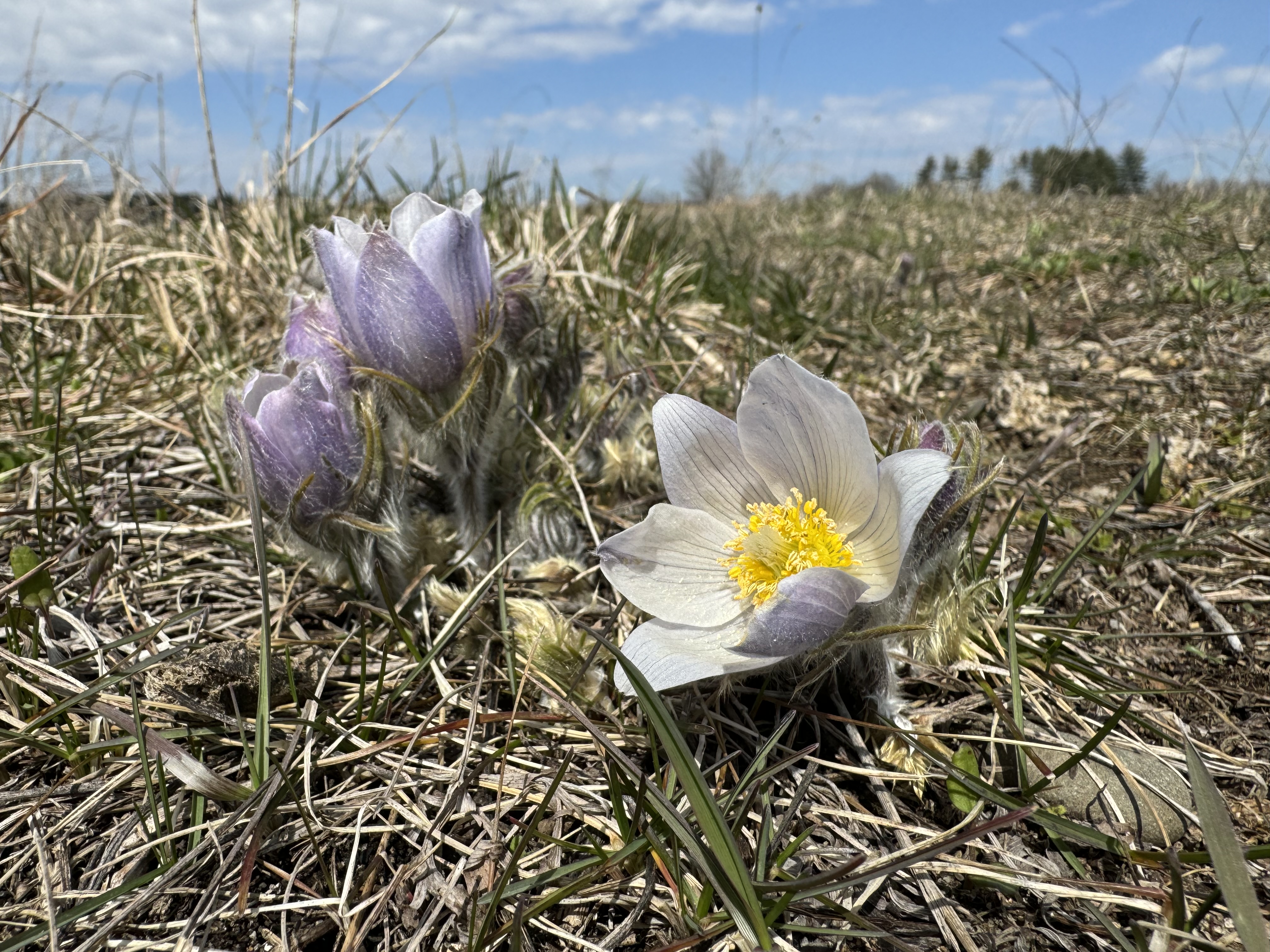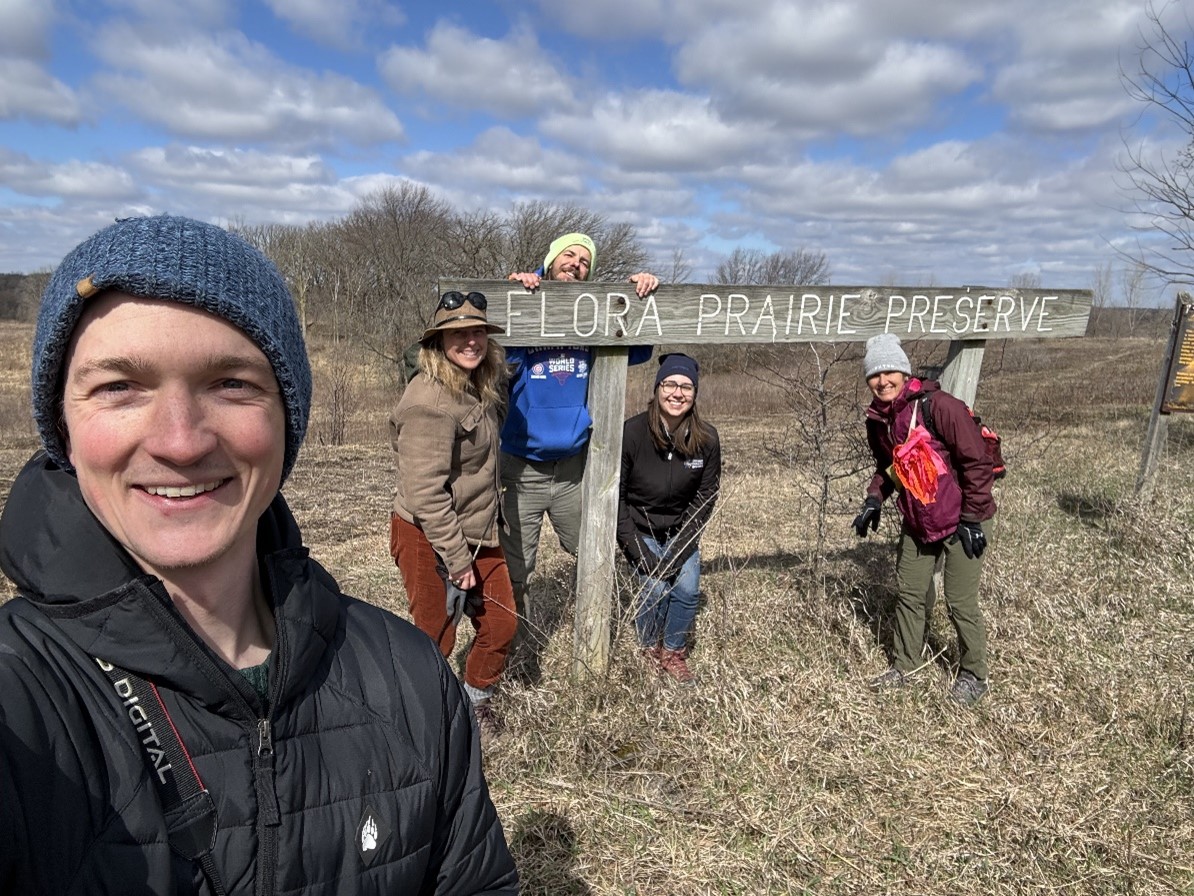
Image Credit: Grant Fessler
Left: Prairie Pasqueflower (Pulsatilla nuttalliana) in bloom at Nachusa Grasslands, March 28th, 2024. Photo by Grant Fessler.
The Plants of Concern team and friends officially kicked off the 2024 monitoring season last month with visits to populations of one of northern Illinois’ earliest blooming species, the prairie pasqueflower (Pulsatilla nuttalliana, also known as P. patens ssp. multifida). With the unusually warm winter this year, pasqueflower, like many other spring-blooming species, had awoken early. Typically, Pulsatilla nuttalliana begins blooming in late-March and early-April, but this year it was observed in bloom as early as March 10th in the Rockford area! Nevertheless, the early blooms of this charismatic native species were enthusiastically welcomed by us rare plant monitors, ready for the start of a new growing season.
The late-March trip not only ushered in the start of the monitoring season but also symbolized the beginning of Plants of Concern’s expansion into northwestern Illinois. Thanks to IDNR funding and a gift from an anonymous donor, Plants of Concern was able to hire Grant Fessler to bring the program into this new region in 2024.
 Pulsatilla nuttalliana waiting for the snow to melt on March 24th in Winnebago County, IL. Photo courtesy of Daniel Pohl.
Pulsatilla nuttalliana waiting for the snow to melt on March 24th in Winnebago County, IL. Photo courtesy of Daniel Pohl.
On the chilly, late-March morning, Plants of Concern staff, including Gretel Kiefer, Ingrid Felsl, and Grant Fessler, rendezvoused with INHS and IDNR Field Forester Daniel Pohl and Friends of Illinois Nature Preserves Field Representative Jessie Crow-Mermel at Flora Prairie Nature Preserve, a remnant dry dolomite prairie in Boone County. In classic early-spring fashion, the Rockford area had received several inches of snow just a few days before (see above photo). Luckily, the snow had melted, and conditions were prime for monitoring the pasqueflower.
 Monitors searching for Pulsatilla at recently burned Flora Prairie Nature Preserve. Photo by Grant Fessler.
Monitors searching for Pulsatilla at recently burned Flora Prairie Nature Preserve. Photo by Grant Fessler.
We were pleased to see that a prescribed burn and brush clearing had recently occurred at the prairie thanks to Boone County Conservation District and volunteer efforts. The management activities, along with Daniel’s knowledge of the site, made our job easy, as we quickly spotted several clumps of pasqueflower. Their purple-pink petals stood out immediately against the blackish brown of the burned prairie. What a sight they were for our weary, bloom-starved eyes! It is always a special moment when one lays eyes on the first blooms of spring and is reminded that the warmth and green of summer is not far behind. Spreading out, we explored the prairie and monitored several subpopulations of Pulsatilla. Concluding our work at the site, we hopped in our vehicles and headed to Harlem Hills Nature Preserve in Winnebago County.
Harlem Hills is a 96-acre site nestled within the suburban sprawl of Rockford, IL and represents one of the best and largest examples of gravel hill prairie in the state. It is home to numerous rare, threatened, and endangered plants, including prairie pasqueflower. Our visit to Harlem Hills was steeped in serendipity, as we immediately ran into Plants of Concern founder and now retired program manager, Susanne Masi, accompanied by talented Chicago-region nature photographer and Plants of Concern community scientist, Dave Schwaegler. Unplanned, we had brought ourselves to the exact same spot at the same time! After we all shared laughs about the coincidence and chatted for a while, we set out to monitor the pasqueflowers.
As of 2023, Pulsatilla nuttalliana was placed on the Illinois plant watchlist, as there are initial concerns about the species’ long-term viability in the Prairie State. Northern Illinois, in fact, harbors some of the southernmost populations of this species in eastern North America (see maps below). Botanists with decades of experience with this species in Illinois have expressed concern that pasqueflower may be declining. Specifically, they have noted changes in the number of flowering stems per clump. Plants of Concern is collecting data on this phenomenon to assess how northern Illinois populations change over time.
 Pulsatilla nuttalliana observation map retrieved from iNaturalist on April 3rd, 2024. https://www.inaturalist.org/taxa/881504-Pulsatilla-nuttalliana
Pulsatilla nuttalliana observation map retrieved from iNaturalist on April 3rd, 2024. https://www.inaturalist.org/taxa/881504-Pulsatilla-nuttalliana
It was a great start to the POC monitoring season! Thanks to Daniel and Jessie for joining and lending a hand. The POC team is excited to be expanding to a new part of the state. If you are interested in monitoring rare plants in northwestern Illinois, contact Grant Fessler at gfessler@chicagobotanic.org. Also, keep an eye out for upcoming Plants of Concern forays and monitoring events at our website https://plantsofconcern.org/news-and-events.
 Prairie pasqueflower monitoring team at Flora Prairie, Boone County, IL. From Left to right: Grant Fessler, Jessie Crow-Mermel, Daniel Pohl, Ingrid Felsl, and Gretel Kiefer.
Prairie pasqueflower monitoring team at Flora Prairie, Boone County, IL. From Left to right: Grant Fessler, Jessie Crow-Mermel, Daniel Pohl, Ingrid Felsl, and Gretel Kiefer.
Article by Grant Fessler